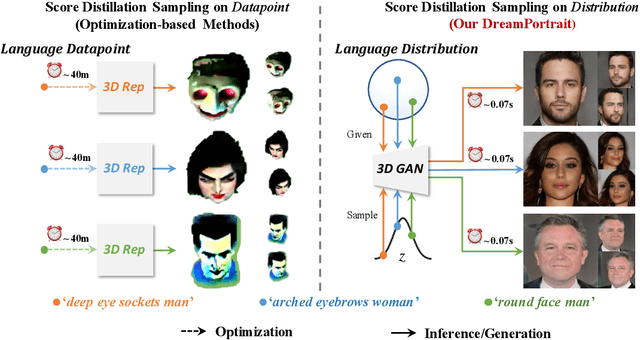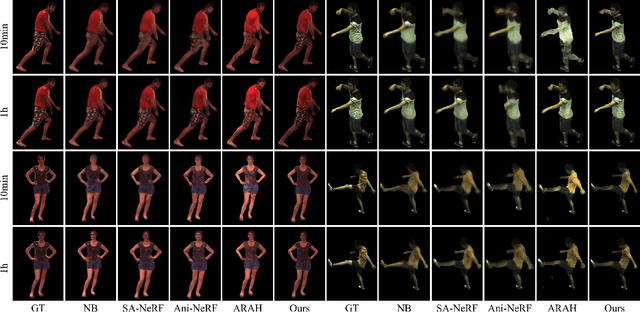Yiji Cheng
PromptEnhancer: A Simple Approach to Enhance Text-to-Image Models via Chain-of-Thought Prompt Rewriting
Sep 04, 2025Abstract:Recent advancements in text-to-image (T2I) diffusion models have demonstrated remarkable capabilities in generating high-fidelity images. However, these models often struggle to faithfully render complex user prompts, particularly in aspects like attribute binding, negation, and compositional relationships. This leads to a significant mismatch between user intent and the generated output. To address this challenge, we introduce PromptEnhancer, a novel and universal prompt rewriting framework that enhances any pretrained T2I model without requiring modifications to its weights. Unlike prior methods that rely on model-specific fine-tuning or implicit reward signals like image-reward scores, our framework decouples the rewriter from the generator. We achieve this by training a Chain-of-Thought (CoT) rewriter through reinforcement learning, guided by a dedicated reward model we term the AlignEvaluator. The AlignEvaluator is trained to provide explicit and fine-grained feedback based on a systematic taxonomy of 24 key points, which are derived from a comprehensive analysis of common T2I failure modes. By optimizing the CoT rewriter to maximize the reward from our AlignEvaluator, our framework learns to generate prompts that are more precisely interpreted by T2I models. Extensive experiments on the HunyuanImage 2.1 model demonstrate that PromptEnhancer significantly improves image-text alignment across a wide range of semantic and compositional challenges. Furthermore, we introduce a new, high-quality human preference benchmark to facilitate future research in this direction.
InstantCharacter: Personalize Any Characters with a Scalable Diffusion Transformer Framework
Apr 16, 2025Abstract:Current learning-based subject customization approaches, predominantly relying on U-Net architectures, suffer from limited generalization ability and compromised image quality. Meanwhile, optimization-based methods require subject-specific fine-tuning, which inevitably degrades textual controllability. To address these challenges, we propose InstantCharacter, a scalable framework for character customization built upon a foundation diffusion transformer. InstantCharacter demonstrates three fundamental advantages: first, it achieves open-domain personalization across diverse character appearances, poses, and styles while maintaining high-fidelity results. Second, the framework introduces a scalable adapter with stacked transformer encoders, which effectively processes open-domain character features and seamlessly interacts with the latent space of modern diffusion transformers. Third, to effectively train the framework, we construct a large-scale character dataset containing 10-million-level samples. The dataset is systematically organized into paired (multi-view character) and unpaired (text-image combinations) subsets. This dual-data structure enables simultaneous optimization of identity consistency and textual editability through distinct learning pathways. Qualitative experiments demonstrate the advanced capabilities of InstantCharacter in generating high-fidelity, text-controllable, and character-consistent images, setting a new benchmark for character-driven image generation. Our source code is available at https://github.com/Tencent/InstantCharacter.
FireEdit: Fine-grained Instruction-based Image Editing via Region-aware Vision Language Model
Mar 25, 2025Abstract:Currently, instruction-based image editing methods have made significant progress by leveraging the powerful cross-modal understanding capabilities of vision language models (VLMs). However, they still face challenges in three key areas: 1) complex scenarios; 2) semantic consistency; and 3) fine-grained editing. To address these issues, we propose FireEdit, an innovative Fine-grained Instruction-based image editing framework that exploits a REgion-aware VLM. FireEdit is designed to accurately comprehend user instructions and ensure effective control over the editing process. Specifically, we enhance the fine-grained visual perception capabilities of the VLM by introducing additional region tokens. Relying solely on the output of the LLM to guide the diffusion model may lead to suboptimal editing results. Therefore, we propose a Time-Aware Target Injection module and a Hybrid Visual Cross Attention module. The former dynamically adjusts the guidance strength at various denoising stages by integrating timestep embeddings with the text embeddings. The latter enhances visual details for image editing, thereby preserving semantic consistency between the edited result and the source image. By combining the VLM enhanced with fine-grained region tokens and the time-dependent diffusion model, FireEdit demonstrates significant advantages in comprehending editing instructions and maintaining high semantic consistency. Extensive experiments indicate that our approach surpasses the state-of-the-art instruction-based image editing methods. Our project is available at https://zjgans.github.io/fireedit.github.io.
RodinHD: High-Fidelity 3D Avatar Generation with Diffusion Models
Jul 11, 2024



Abstract:We present RodinHD, which can generate high-fidelity 3D avatars from a portrait image. Existing methods fail to capture intricate details such as hairstyles which we tackle in this paper. We first identify an overlooked problem of catastrophic forgetting that arises when fitting triplanes sequentially on many avatars, caused by the MLP decoder sharing scheme. To overcome this issue, we raise a novel data scheduling strategy and a weight consolidation regularization term, which improves the decoder's capability of rendering sharper details. Additionally, we optimize the guiding effect of the portrait image by computing a finer-grained hierarchical representation that captures rich 2D texture cues, and injecting them to the 3D diffusion model at multiple layers via cross-attention. When trained on 46K avatars with a noise schedule optimized for triplanes, the resulting model can generate 3D avatars with notably better details than previous methods and can generalize to in-the-wild portrait input.
GaussianCube: Structuring Gaussian Splatting using Optimal Transport for 3D Generative Modeling
Apr 05, 2024Abstract:3D Gaussian Splatting (GS) have achieved considerable improvement over Neural Radiance Fields in terms of 3D fitting fidelity and rendering speed. However, this unstructured representation with scattered Gaussians poses a significant challenge for generative modeling. To address the problem, we introduce GaussianCube, a structured GS representation that is both powerful and efficient for generative modeling. We achieve this by first proposing a modified densification-constrained GS fitting algorithm which can yield high-quality fitting results using a fixed number of free Gaussians, and then re-arranging the Gaussians into a predefined voxel grid via Optimal Transport. The structured grid representation allows us to use standard 3D U-Net as our backbone in diffusion generative modeling without elaborate designs. Extensive experiments conducted on ShapeNet and OmniObject3D show that our model achieves state-of-the-art generation results both qualitatively and quantitatively, underscoring the potential of GaussianCube as a powerful and versatile 3D representation.
Plan, Posture and Go: Towards Open-World Text-to-Motion Generation
Dec 22, 2023Abstract:Conventional text-to-motion generation methods are usually trained on limited text-motion pairs, making them hard to generalize to open-world scenarios. Some works use the CLIP model to align the motion space and the text space, aiming to enable motion generation from natural language motion descriptions. However, they are still constrained to generate limited and unrealistic in-place motions. To address these issues, we present a divide-and-conquer framework named PRO-Motion, which consists of three modules as motion planner, posture-diffuser and go-diffuser. The motion planner instructs Large Language Models (LLMs) to generate a sequence of scripts describing the key postures in the target motion. Differing from natural languages, the scripts can describe all possible postures following very simple text templates. This significantly reduces the complexity of posture-diffuser, which transforms a script to a posture, paving the way for open-world generation. Finally, go-diffuser, implemented as another diffusion model, estimates whole-body translations and rotations for all postures, resulting in realistic motions. Experimental results have shown the superiority of our method with other counterparts, and demonstrated its capability of generating diverse and realistic motions from complex open-world prompts such as "Experiencing a profound sense of joy". The project page is available at https://moonsliu.github.io/Pro-Motion.
Efficient Text-Guided 3D-Aware Portrait Generation with Score Distillation Sampling on Distribution
Jun 03, 2023



Abstract:Text-to-3D is an emerging task that allows users to create 3D content with infinite possibilities. Existing works tackle the problem by optimizing a 3D representation with guidance from pre-trained diffusion models. An apparent drawback is that they need to optimize from scratch for each prompt, which is computationally expensive and often yields poor visual fidelity. In this paper, we propose DreamPortrait, which aims to generate text-guided 3D-aware portraits in a single-forward pass for efficiency. To achieve this, we extend Score Distillation Sampling from datapoint to distribution formulation, which injects semantic prior into a 3D distribution. However, the direct extension will lead to the mode collapse problem since the objective only pursues semantic alignment. Hence, we propose to optimize a distribution with hierarchical condition adapters and GAN loss regularization. For better 3D modeling, we further design a 3D-aware gated cross-attention mechanism to explicitly let the model perceive the correspondence between the text and the 3D-aware space. These elaborated designs enable our model to generate portraits with robust multi-view semantic consistency, eliminating the need for optimization-based methods. Extensive experiments demonstrate our model's highly competitive performance and significant speed boost against existing methods.
Efficient Meshy Neural Fields for Animatable Human Avatars
Mar 23, 2023



Abstract:Efficiently digitizing high-fidelity animatable human avatars from videos is a challenging and active research topic. Recent volume rendering-based neural representations open a new way for human digitization with their friendly usability and photo-realistic reconstruction quality. However, they are inefficient for long optimization times and slow inference speed; their implicit nature results in entangled geometry, materials, and dynamics of humans, which are hard to edit afterward. Such drawbacks prevent their direct applicability to downstream applications, especially the prominent rasterization-based graphic ones. We present EMA, a method that Efficiently learns Meshy neural fields to reconstruct animatable human Avatars. It jointly optimizes explicit triangular canonical mesh, spatial-varying material, and motion dynamics, via inverse rendering in an end-to-end fashion. Each above component is derived from separate neural fields, relaxing the requirement of a template, or rigging. The mesh representation is highly compatible with the efficient rasterization-based renderer, thus our method only takes about an hour of training and can render in real-time. Moreover, only minutes of optimization is enough for plausible reconstruction results. The disentanglement of meshes enables direct downstream applications. Extensive experiments illustrate the very competitive performance and significant speed boost against previous methods. We also showcase applications including novel pose synthesis, material editing, and relighting. The project page: https://xk-huang.github.io/ema/.
 Add to Chrome
Add to Chrome Add to Firefox
Add to Firefox Add to Edge
Add to Edge